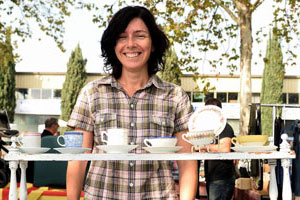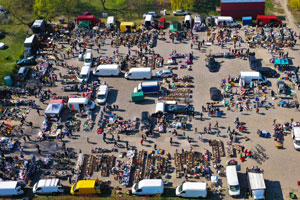 Becoming a Vendor
Becoming a Vendor
Whether you are looking to get rid of some old stuff around the house or would like to start a permanent business, anyone can become a flea market vendor. Here are some simple steps to help you get started:
Register for a sales certificate.
The exact documentation you will need is different in every state, but you need to register for a sales or tax permit with your state’s Tax Department. This allows you to charge sales tax on every purchase, and almost all states and markets require that you have these to sell at a flea market.
- All sellers must obtain the tax certificate before you plan on selling, although how far in advance also depends on the state.
- Some states have different types of tax certificates — some are the same no matter how long you have been selling for, and some issue temporary certificates depending on how frequently you sell.
- When in doubt, ask the flea market you are selling at and they can give you all of the information you need.
 Check out nearby flea markets.
Check out nearby flea markets.
If you live in an area that has multiple markets, it’s good practice to spend a few weekends checking them out and deciding where you would like to sell. If there’s a market close to you, they can give you some necessary information to set up a booth. Here are some things to lookout for:
- Look to see where the booths are set up and where the most traffic comes through.
- Note what other vendors are selling and how much their products go for. You are likely to be more successful if you’re selling merchandise that not many other businesses have, or at least sell at competitive prices.
Ask how much a booth rental costs.
All flea markets will charge sellers a fee to rent booth space, and it varies from market to market. Make sure you know what the rate is up front. Here are some important tips to keep in mind:
- Some markets have daily or monthly rates. If you have never sold at a flea market before, you probably only want to pay for just one day until you’re sure you want to commit to a full month.
- Some markets also have booth space in covered areas. These may cost more, but it is worth having since you will be safe from rain and weather.
Decide where you would like your booth.
Seeing each flea market in person is very helpful to scope out the best selling spots. Before you register for any booth:
- It is best to be located near the entrance as well as in an area where there seems to be a lot of foot traffic.
- You might not get your first choices for booths, so make sure to have a couple of different options handy.
Register for a booth.
Once you’ve decided which market you would like to sell at, find out how to go about registering for a booth and reserving space. Some flea markets will allow you to pay and reserve a spot in advance, while others give out booth spaces on a first-come-first-serve basis. Always be sure to check out their website or Facebook page to see how each market allows vendors to register. If your flea market assigns booth spaces on the same day as you are selling, try to get there early to increase your chances of getting the best spot.
 Acquire inventory.
Acquire inventory.
If you already make a product, such as jewelry, soap, or candles, be sure you have enough merchandise in stock to be able to sell. If you rent a booth, you don’t want to run out of products right away. If you do not make your own items, then you can acquire inventory by purchasing merchandise from garage sales or thrift stores.
Another good way to start gathering inventory is by hosting your own garage or rummage sale at the flea market. This gives you enough products to start with and also eliminates the need for you to advertise the garage sale since flea markets will advertise themselves.
If you’re experienced, already own a store, or have bulk wholesale items you’ve purchased, a flea market can be a great way to move stock you already have. WholesaleCentral.com can also be a great way to find new products to sell.
Calculate prices.
One of the most important aspects of becoming a flea market seller is being able to make a profit off of the merchandise you sell. You can calculate ahead of time how much it will cost to either make or buy what you’re selling, and how much of a profit you need to make. Adding these two amounts together will give you your selling price.
Price all of your items.
Once you’ve calculated prices for all of your products, make sure you have clearly marked prices on all of your goods. No vendor wants to get to the flea market, have a potential customer ask how much something is, and then realize you have forgotten.